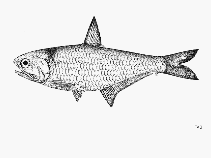http://www.fishbase.org/Summary/speciesSummary.php?genusname=Thryssa&speciesname=aestuaria ---> http://192.134.151.83/Summary/speciesSummary.php?genusname=Thryssa&speciesname=aestuaria
http://192.134.151.83/Summary/speciesSummary.php?genusname=Thryssa&speciesname=aestuaria ---> https://fishbase.mnhn.fr/Summary/speciesSummary.php?genusname=Thryssa&speciesname=aestuaria
https://fishbase.mnhn.fr/Summary/speciesSummary.php?genusname=Thryssa&speciesname=aestuaria ---> https://fishbase.mnhn.fr/summary/Thryssa-aestuaria.html
Thryssa aestuaria, Estuarine thryssa

You can
sponsor
this page
Common name (e.g. trout)
Genus + Species (e.g. Gadus morhua)
-

-
About this page
-
Languages
-
User feedbacks
-
Citation
-
Uploads
-
Related species
-


 Estuarine thryssa
Add your observation in
Fish Watcher
Upload your
photos
and
videos
Estuarine thryssa
Add your observation in
Fish Watcher
Upload your
photos
and
videos
Pictures
|
Google image
 Thryssa aestuaria
Thryssa aestuaria
Picture by
FAO
Teleostei (teleosts) >
Clupeiformes
(Herrings) >
Engraulidae
(Anchovies) > Coiliinae
Etymology:
Thryssa:
Greek, thrissa, -es = shad (Ref.
45335
)
.
More on author:
Ogilby
.
Environment: milieu / climate zone / depth range / distribution range
Ecology
Marine; brackish; pelagic-neritic; depth range 0 - 50 m (Ref.
189
). Tropical; 7°S - 32°S, 112°E - 156°E (Ref.
189
)
Western Pacific: Australia (northern coasts from Onslow east to Gulf of Carpentaria; and eastern coasts from Brisbane south to 30°S, but presumably to the north also) and Papua New Guinea.
Size / Weight / Age
Maturity: L
m
?
range ? - ? cm
Max length : 13.8 cm SL male/unsexed; (Ref.
189
)
Dorsal
spines
(total): 0;
Anal
spines
: 0;
Anal
soft rays
: 30 - 34. Belly with 14 to 16 + 8 or 9 = 22 to 25 keeled scutes from isthmus to anus. Maxilla short, reaching to hind border of pre-operculum; first supra-maxilla short, about half length of second. Pseudobranch very short. A diffuse saddle on nape; no dark blotch behind gill opening.
Presumed marine, pelagic, coastal, but also estuarine, thus tolerating lowered salinities. More data needed.
Life cycle and mating behavior
Maturity
|
Reproduction
|
Spawning
|
Eggs
|
Fecundity
|
Larvae
Wongratana, T., T.A. Munroe and M. Nizinski
, 1999. Order Clupeiformes. Engraulidae. Anchovies. p. 1698-1753. In K.E. Carpenter and V.H. Niem (eds.) FAO species identification guide for fishery purposes. The living marine resources of the WCP. Vol. 3. Batoid fishes, chimaeras and bony fishes part 1 (Elopidae to Linophrynidae). FAO, Rome. (Ref.
9822
)
IUCN Red List Status (Ref.
130435
)
Least Concern (LC)
; Date assessed:
17 July 2017
CITES
Not Evaluated
Not Evaluated
Threat to humans
Harmless
Human uses
FAO - Publication:
search
|
FishSource
|
More information
Countries
FAO areas
Ecosystems
Occurrences
Introductions
Stocks
Ecology
Diet
Food items
Food consumption
Ration
Common names
Synonyms
Metabolism
Predators
Ecotoxicology
Reproduction
Maturity
Spawning
Spawning aggregation
Fecundity
Eggs
Egg development
Age/Size
Growth
Length-weight
Length-length
Length-frequencies
Morphometrics
Morphology
Larvae
Larval dynamics
Recruitment
Abundance
BRUVS
References
Aquaculture
Aquaculture profile
Strains
Genetics
Electrophoreses
Heritability
Diseases
Processing
Nutrients
Mass conversion
Collaborators
Pictures
Stamps, Coins Misc.
Sounds
Ciguatera
Speed
Swim. type
Gill area
Otoliths
Brains
Vision
Tools
E-book
|
Field guide
|
Identification keys
|
Length-frequency wizard
|
Life-history tool
|
Point map
|
Classification Tree
|
Catch-MSY
|
Special reports
Check for Aquarium maintenance
|
Check for Species Fact Sheets
|
Check for Aquaculture Fact Sheets
Download XML
Summary page
|
Point data
|
Common names
|
Photos
Internet sources
AFORO (otoliths) |
Aquatic Commons
|
BHL
|
Cloffa
|
BOLDSystems
|
Websites from users
|
Check FishWatcher
|
CISTI
|
Catalog of Fishes
:
genus
,
species
|
DiscoverLife
|
ECOTOX
| FAO - Publication:
search
|
Faunafri
| Fishipedia |
Fishtrace
| GenBank:
genome
,
nucleotide
| GloBI |
Google Books
|
Google Scholar
|
Google
| IGFA World Record |
MitoFish
|
Otolith Atlas of Taiwan Fishes
|
PubMed
| Reef Life Survey | Socotra Atlas |
Tree of Life
| Wikipedia:
Go
,
Search
| World Records Freshwater Fishing |
Zoological Record
Estimates based on models
Preferred temperature (Ref.
123201
): 24.2 - 28.7, mean 27.5 °C (based on 406 cells).
Phylogenetic diversity index (Ref.
82804
): PD
50
= 0.5000 [Uniqueness, from 0.5 = low to 2.0 = high].
Bayesian length-weight: a=0.00724 (0.00313 - 0.01677), b=3.04 (2.85 - 3.23), in cm total length, based on LWR estimates for this (Sub)family-body shape (Ref.
93245
).
Trophic level (Ref.
69278
): 3.4 ±0.5 se; based on size and trophs of closest relatives
Resilience (Ref.
120179
): High, minimum population doubling time less than 15 months (k=1.56).
Fishing Vulnerability (Ref.
59153
): Low vulnerability (10 of 100).
Back to Search
Random Species
Back to Top
Accessed through:
Not available
FishBase mirror site :
localhost
Page last modified by :
mrius-barile
- 20 July 2016
Fatal error
: Uncaught ArgumentCountError: Too few arguments to function checkEcotox(), 1 passed in /var/www/html/summary/speciessummary.php on line 2304 and exactly 3 expected in /var/www/html/includes/speciessummary.lib.php:2579 Stack trace: #0 /var/www/html/summary/speciessummary.php(2304): checkEcotox() #1 {main} thrown in
/var/www/html/includes/speciessummary.lib.php
on line
2579
|